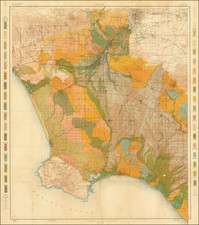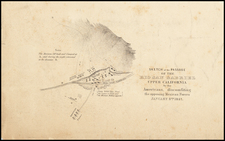Rare W.W. Elliott chromolithographic view of Pleasanton and LIvermore, California, published by W.P. Bartlett, who was then the owner of the LIvermore Herald.
The view includes smaller vignettes of the Public School in Livermore; Washington Hotel Adrian A Gilbert, Prop; McLeod Block, Livermore; Farmers' Union Building, Livermore, Cal.; the Livermore Town Hall, Catholic Church, Prebysterian Church and M.E. Church; Livermore Mills Laumeister & Hanna Prop's; Livermore College, J.D. Smith Principal; Oak Springs Vineyard, 100 Acres in Vines; Wholesale & Retail Liquor Store of Henry Gardemeyer; View of "A California Utopia . . . " and Sample Products of Rose & Back Tracts Near Pleasanton.
The old railroad turntable, used to turn around extra engines that were used to climb the Altamont Pass, can bee seen near the top right, on one of the branches which split off from the main track in front of the engine. St. Michaels church (#49) can be seen near the bottom, just to the right of the train approaching from the bottom left. This building burned in 1916.
The railroad tracks are the old set, run by the Central Pacific (later Southern Pacific). Railroad Ave. can be seen north of the tracks. The street to the north (right) of Railroad Ave. is Oak Street (it is labeled). The Western Pacific tracks were built on what used to be Oak Street. This street no longer exists except for a small portion along the tracks.
Interestingly, this view was published in the same year that electric street lights were introduced to the town of Livermore.
OCLC locates a reduced sized photocopy of the view at the Library of Congress.
The text below the map reads as follows:
Livermore Valley, California
Is a saucer-like basin in the heart of the Coast Range of Mountains, 40 miles east of San Francisco. It is hemmed in by high, rolling hills, and lofty and rugged mountain ridges, on every side. An altitude of 500 feet above sea level, ensures pure air and freedom from frosts; a location midway between the sea coast and the great valleys of the interior renders it free from the cold and fogs of the one, and the intense summer heat of the other. There is no irrigation - consequently, no miasma. The lofty wall-like ridges tot he right of the picture hold back the coast fogs, and on more than a hundred days in each year, then San Francisco is wrapped in chilly damp and mist, Livermore Valley is bathed in charming sunshine. The air is dry, sparkling and pure, and has won back to health hundreds of invalids, to whom San Francisco's fogs and winds were bringing certain death.
VINEYARD PLANTING begin in Livermore Valley in1882. The discovery that certain orchard trees succeed was made but two years ago. There are now 6,000 acres of vineyard, mostly in bearing, and 1,500 of young orchard - mainly almonds, apricots and pears. But a portion is shown in the above view. The planting progresses at the rate of 1,000 acres a year. The wine output in1888 was upwards of 500,000 gallons. Only the best European varieties have been planted. Livermore Valley wines have for three years taken high rank in annual competitions at State Viticultural Conventions.
Town of Livermore.
The town of Livermore is situated in the center of the valley. Its population is 1880, was 855; in 1888, 2500. Its resources are various - stock and sheep raising, grain and hay growing, orcharding, vine-growing, and coal and chrome-mining, being the most prominent. It has numerous manufacturers, turning out in 1888, $500,000 worth of perfected products. Has a rapidly developing tributary country of upwards of 600 square miles of territory. The town is built on a gravelly loam foundation, making perfect roadways, summer or winter. There ore many charming mountain canyons, offering inviting drives at all seasons. The Aqua de Vida Springs, a mountain health and pleasure resort, 10 miles distant, opened last season, became very popular, attracting many of the most prominent people of the State.
Town of Pleasanton.
At the west end of the beautiful Livermore Valley, shown in the distance, at the extreme right of the picture is a tract of rich, deep, moist alluvial land, several thousand acres in extent; contiguous to the town of Pleasanton. This land, formerly all a willow swamp, is now being drained, cleared and tilled. The lower marginal view of Pleasanton and the Rose-Black Tracts, shows this rich country and the extent of its reclamation and cultivation. The range and extend of its product, seem almost without limit. The sketch of a sample group of vegetables scarcely does justice to the reality and is certainly in no wise exaggerated. A canal 3 1/2 miles long, is in course of constructions which will not only drain these lands, but protect them from all danger from overflow. Pleasanton is a charming town embowered in foliage, and the productiveness of its soil is marvelous.
The Schmidt Lithography Company was based in San Francisco. Max Schmidt, a German immigrant, founded his first printing business in 1873, and he was one of the first printers to use lithography on the West Coast. His plant burned twice, in 1884 and 1886, but by the 1890s he ran a factory in San Francisco, as well as branches in Portland and Seattle.
During the 1906 earthquake and fire the company’s premises were destroyed again. Schmidt quickly acquired a nearby paper factory and production continued practically uninterrupted. Within two years of the fire, Schmidt had rebuilt on the site of his former factory at the corner of Second and Bryant Streets.
Schmidt’s company was best known for its printed labels, but they also produced other items like separately-issued prints. The company was once the largest printing company on the West Coast and today they are remembered for the clock tower that still stands at Second and Bryant Streets.









![(Mexican War) [ Proposed United States - Mexico Military Border - January 1848 ]](https://storage.googleapis.com/raremaps/img/small/99246.jpg)

![[Winchester Bay, Oregon to Crescent City California] Pt. St. George to Umpqua River California and Oregon](https://storage.googleapis.com/raremaps/img/small/79292.jpg)
![Index Map of the Civil Code of California Designed and Executed By Curtis Lindley . . . [bound into] Revised Laws of the State of California; In Four Codes: Political, Civil, Civil Procedure and Penal . . .](https://storage.googleapis.com/raremaps/img/small/84298.jpg)
![[ Orange County ] Geological Sketch Map S.E. Portion of Orange Co. California State Mining Bureau . . .](https://storage.googleapis.com/raremaps/img/small/76946.jpg)
